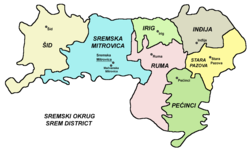Srem District
Srem District Sremski okrug Сремски округ | ||
|---|---|---|
Municipalities 6 and 1 city | | |
| Settlements | 109 | |
| - Cities and towns | 7 | |
| - Villages | 102 | |
| Website | www | |



The Srem District (Serbian: Сремски округ / Sremski okrug, pronounced [srɛ̂ːmskiː ôkruːɡ]) is one of seven administrative districts of the autonomous province of Vojvodina, Serbia. It lies in the geographical regions of Syrmia and Mačva. According to the 2022 census results, it has a population of 282,547 inhabitants. The administrative center is the city of Sremska Mitrovica.
Name
In
Administration
The Srem District is one of seven districts (first-level administrative divisions) of Vojvodina (and 29 of Serbia). Districts are regional centers and do not have any form of self-government. The District includes the municipalities of:
History
In
During the administration of the medieval
At the end of the Austro-Russian-Turkish War of 1735-1739, there was a migration of Albanians from the Kelmendi tribe to Srem, who were recorded as speaking Albanian as late as 1921.[1]
During Habsburg administration (18th-19th century), the area was divided between the Syrmia County and the Military Frontier. In the 1850s, northern parts of the area were part of the Novi Sad District, but were again included into Syrmia County after 1860. Since the abolishment of the Military Frontier in 1882, Syrmian parts of the Frontier were also included into Syrmia County.
During the royal
During the
Demographics
| Year | Pop. | ±% |
|---|---|---|
| 1948 | 209,943 | — |
| 1953 | 223,642 | +6.5% |
| 1961 | 260,226 | +16.4% |
| 1971 | 287,474 | +10.5% |
| 1981 | 306,085 | +6.5% |
| 1991 | 309,981 | +1.3% |
| 2002 | 335,901 | +8.4% |
| 2011 | 312,278 | −7.0% |
| 2021 | 284,436 | −8.9% |
| Source: [2] | ||
According to the last official census done in 2011, the Srem District has 312,278 inhabitants.
Ethnic groups
Ethnic composition of the Srem district:[3]
| Ethnic group | Population | % |
|---|---|---|
| Serbs | 265,272 | 84.95% |
| Croats | 8,758 | 2.80% |
| Slovaks | 8,154 | 2.61% |
| Romani | 5,488 | 1.76% |
Hungarians |
3,789 | 1.21% |
| Rusyns | 1,689 | 0.54% |
| Yugoslavs | 1,122 | 0.36% |
| Ukrainians | 1,055 | 0.34% |
| Macedonians | 606 | 0.19% |
| Montenegrins | 493 | 0.16% |
| Germans | 249 | 0.08% |
Muslims |
246 | 0.08% |
| Slovenes | 244 | 0.08% |
| Russians | 183 | 0.06% |
| Albanians | 173 | 0.06% |
| Others | 14,757 | 4.73% |
| Total | 312,278 |
Culture
The monasteries on the Fruška Gora mountain are the greatest cultural treasures of this region. They include the Grgeteg Monastery from 1471 and the Jazak Monastery from 1522.
The Krušedol Monastery is a true treasury of the Vojvodinan painting. It was founded in 1514 as an endowment of Orthodox bishop Maksim Branković and his mother Angelina.
In the Novo Hopovo Monastery, the church architecture and fresco paintings are particularly attractive. The exact time of its first construction is unknown, but 1765 is known as the year of its reconstruction.
See also
- Administrative divisions of Serbia
- Districts of Serbia
References
- ^ "Karl Gottlieb von Windisch: On the Kelmendi in Syrmia".
- ^ "2011 Census of Population, Households and Dwellings in the Republic of Serbia" (PDF). stat.gov.rs. Statistical Office of the Republic of Serbia. Retrieved 16 January 2017.
- ^ "Попис становништва, домаћинстава и станова 2011. у Републици Србији" (PDF). stat.gov.rs. Republički zavod za statistiku. Retrieved 16 January 2017.
Note: All official material made by Government of Serbia is public by law. Information was taken from official website.
